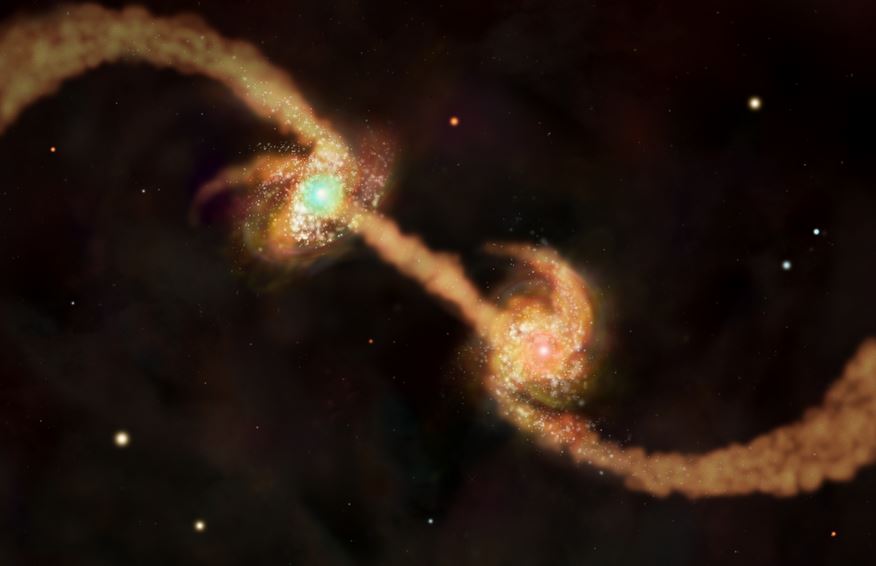Dark matter appears to influence both the size and rate of growth of black holes, say scientists at the Harvard-Smithsonian Center for Astrophysics (CfA). They found a link between the size of black holes and the amount of dark matter a galaxy holds.
At the center of every massive galaxy one can find a black hole. The heavier the galaxy, the larger its black hole. Scientists have never been able to fully explain the link between the two. After all, the black hole is infinitely smaller and less massive than its home galaxy.
Lead author Akos Bogdan, an Einstein Postdoctoral Fellow at CfA, and colleagues carried out a new study of elliptical galaxies, i.e. football-shaped (UK English: rugby-ball shaped) galaxies. They discovered that dark matter appears to influence black hole growth.

An illustration of two spiral galaxies – each with supermassive black holes at their center – as they are about to collide and form an elliptical galaxy. (Credit: NASA/CXC/M.Weiss. Image: CfA)
Dark matter refers to material we are unable to detect from its emitted radiation. However, we are aware of its presence because of its gravitational effects on visible matter, like galaxies and stars. Most of the Universe consists of dark matter.
Dr. Bogdan said:
“There seems to be a mysterious link between the amount of dark matter a galaxy holds and the size of its central black hole, even though the two operate on vastly different scales.”
Sought the address a controversy
In this study, the researchers had set out to find the answer to a controversy. Previous observations had found a link between the mass of the central black hole and the total mass of stars in elliptical galaxies.
However, more recently, other studies have pointed to a tight correlation between the masses of black holes and the dark matter halos of galaxies. Nobody was sure which relationship dominated.
Scientists say that dark matter in our Universe outweighs normal matter (the stuff we can see) by a factor of 6 to 1. They are certain dark matter exists from its gravitational effects. It holds galaxies and galaxy clusters together.
A dark matter halo is a galaxy’s hypothetical component that envelops the galactic disc and extends far beyond the edge of the visible galaxy. Every galaxy has a halo of dark matter around it that weighs as much as one trillion suns and extends hundreds of thousands of light years.
Dr. Bogdan and Dr. Andy Goulding, an observational astrophysicist at Princeton University, studied over 3,000 elliptical galaxies in order to investigate the association between dark matter halos and supermassive black holes.
They weighed the galaxies’ central black holes by using star motions as a trace. X-ray measurements of hot gas surrounding the galaxies helped them weigh the dark matter halo – the more dark matter there is in a galaxy, the more gas it is able to hold onto.
Stronger link between black hole mass and dark matter mass
They found a clear relationship between black hole mass and the mass of the dark matter held in its home galaxy. This relationship was stronger than the one between a black hole and the galaxy’s stars alone.
The link is probably related to how elliptical galaxies grow. An elliptical galaxy is formed when smaller galaxies merge together, their dark matter and stars mingling and mixing together. As the dark matter weighs more than everything else, it molds the young elliptical galaxy and guides the growth of the central black hole.
Dr. Bogdan explained:
“In effect, the act of merging creates a gravitational blueprint that the galaxy, the stars and the black hole will follow in order to build themselves.”
Their findings have been accepted for publication in the Astrophysical Journal.

